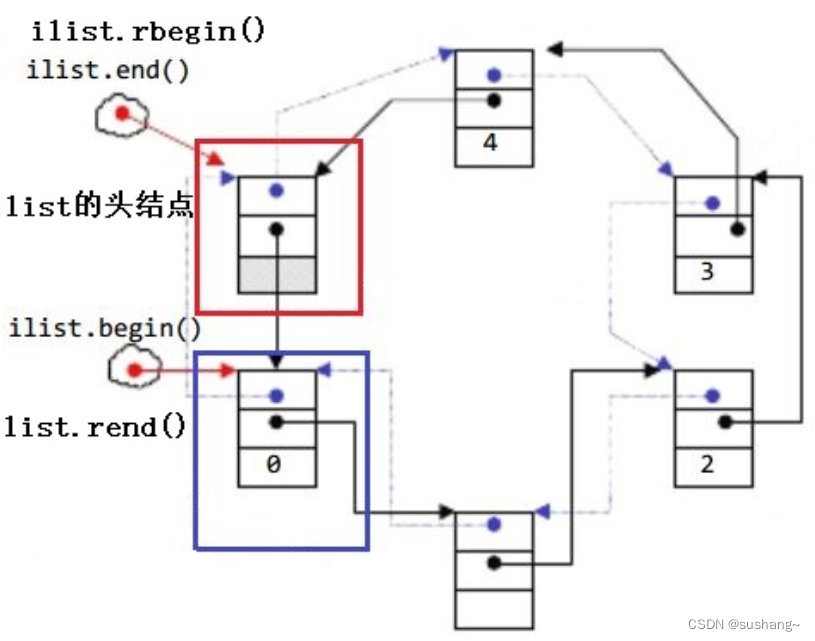C++初阶-list的介绍及使用
2023-12-15 08:44:43
list的介绍及使用
一、list的介绍
- list是可以在常数范围内在任意位置进行插入和删除的序列式容器,并且该容器可以前后双向迭代。
- list的底层是双向链表结构,双向链表中每个元素存储在互不相关的独立节点中,在节点中通过指针指向其前一个元素和后一个元素。
- list与forward_list非常相似:最主要的不同在于forward_list是单链表,只能朝前迭代,已让其更简单高效。
- 与其他的序列式容器相比(array,vector,deque),list通常在任意位置进行插入、移除元素的执行效率更好。
- 与其他序列式容器相比,list和forward_list最大的缺陷是不支持任意位置的随机访问,比如:要访问list的第6个元素,必须从已知的位置(比如头部或者尾部)迭代到该位置,在这段位置上迭代需要线性的时间开销;list还需要一些额外的空间,以保存每个节点的相关联信息(对于存储类型较小元素的大list来说这可能是一个重要的因素)。
二、list的使用
2.1 list的构造
| (constructor)构造函数 | 接口说明 |
|---|---|
| list(size_type n,const value_type& val=value_type()) | 构造的list中包含n个值为val的元素 |
| list() | 构造空的list |
| list(const list& x); | 拷贝构造函数 |
| list(InputIterator first, InputIterator last); | 用[first,last)区间中的元素构造list |
list<int> lt1; // 构造int类型的空容器
list<int> lt2(3, 2); // 构造含有3个2的int类型容器
list<int> lt3(lt2); // 拷贝构造lt2
string s("hello");
list<char> lt4(s.begin(), s.end()); // 利用迭代器构造
2.2 list iterator的使用
此处,大家可暂时将迭代器理解成一个指针,该指针指向list中的某个节点。
| 函数说明 | 接口说明 |
|---|---|
| begin+end | 返回第一个元素的迭代器+返回最后一个元素下一个位置的迭代器 |
| rbegin+rend | 返回第一个元素的reverse_iterator,即end位置,返回最后一个元素下一个位置的reverse_iterator,即begin位置 |

注意
1.begin与end为正向迭代器,对迭代器执行++操作,迭代器向后移动
2.rbegin(end)与rend(begin)为反向迭代器,对迭代器执行++操作,迭代器向前移动
int main()
{
string s("hello");
list<char> lt(s.begin(), s.end());
//正向迭代器遍历容器
list<char>::iterator it = lt.begin();
while (it != lt.end())
{
cout << *it << " ";
it++;
}
cout << endl;
//反向迭代器遍历容器
list<char>::reverse_iterator rit = lt.rbegin();
while (rit != lt.rend())
{
cout << *rit << " ";
rit++;
}
cout << endl;
return 0;
}
2.3 list capacity
| 函数声明 | 接口说明 |
|---|---|
| empty | 检测list是否为空,是返回true,否则返回false |
| size | 返回list中有效节点的个数 |
int main()
{
list<int> lt;
lt.push_back(1);
lt.push_back(2);
cout << lt.size() << endl;
cout << lt.empty() << endl;
}
2.4 list element access
| 函数声明 | 接口说明 |
|---|---|
| front | 返回list的第一个节点中值的引用 |
| back | 返回list的最后一个节点中值的引用 |
int main()
{
list<int> lt;
lt.push_back(1);
lt.push_back(2);
lt.push_back(3);
lt.push_back(4);
cout << lt.front() << endl;
cout << lt.back() << endl;
return 0;
}
2.5 list modifiers
| 函数声明 | 接口说明 |
|---|---|
| push_front | 在list首元素前插入值为val的元素 |
| pop_front | 删除list中第一个元素 |
| push_back | 在list尾部插入值为val的元素 |
| pop_back | 删除list中最后一个元素 |
| insert | 在list position位置中插入值为val的元素 |
| erase | 删除list position位置的元素 |
| swap | 交换两个list中的元素 |
| clear | 清空list中的有效元素 |
int main()
{
list<int> lt;
// 头插数据
lt.push_front(1);
lt.push_front(2);
lt.push_front(3);
for (auto e : lt)
{
cout << e << " ";
}
cout << endl;
// 头删数据
lt.pop_front();
for (auto e : lt)
{
cout << e << " ";
}
cout << endl;
return 0;
}
int main()
{
list<int> lt;
// 尾插数据
lt.push_back(1);
lt.push_back(2);
lt.push_back(3);
for (auto e : lt)
{
cout << e << " ";
}
cout << endl;
// 尾删数据
lt.pop_back();
for (auto e : lt)
{
cout << e << " ";
}
cout << endl;
return 0;
}
list的insert支持三种插入方式
1.在指定位置插入数据
2.在指定位置插入n个值为val的数
3.在指定位置插入一段迭代器区间(左闭右开)
int main()
{
list<int> lt;
lt.push_back(1);
lt.push_back(2);
lt.push_back(3);
list<int>::iterator pos = find(lt.begin(), lt.end(), 2);
lt.insert(pos, 4); //在2的位置插入9
for (auto e : lt)
{
cout << e << " ";
}
cout << endl;
pos = find(lt.begin(), lt.end(), 3);
lt.insert(pos, 3, 5); //在3的位置插入3个5
for (auto e : lt)
{
cout << e << " ";
}
cout << endl;
vector<int> v{ 6, 6 };
pos = find(lt.begin(), lt.end(), 1);
lt.insert(pos, v.begin(), v.end()); //在1的位置插入2个6
for (auto e : lt)
{
cout << e << " ";
}
cout << endl;
return 0;
}
list的erase有两种方式
1.删除指定位置数据
2.删除指定迭代器区间中的数据
int main()
{
list<int> lt;
lt.push_back(1);
lt.push_back(2);
lt.push_back(3);
lt.push_back(4);
list<int>::iterator pos = find(lt.begin(), lt.end(), 2);
lt.erase(pos); // 删除2
for (auto e : lt)
{
cout << e << " ";
}
cout << endl;
pos = find(lt.begin(), lt.end(), 3);
lt.erase(pos, lt.end()); //删除3及其之后的元素
for (auto e : lt)
{
cout << e << " ";
}
cout << endl;
return 0;
}
swap用于交换两个容器的内容
int main()
{
list<int> lt1(3, 2);
list<int> lt2(2, 3);
lt1.swap(lt2); //交换两个容器的内容
return 0;
}
clear用于清空容器,清空后容器的size为0
int main()
{
list<int> lt(3, 2);
lt.clear();
return 0;
}
三、list的迭代器失效问题
??前面说过,此处大家可将迭代器暂时理解成类似于指针,迭代器失效即迭代器所指向的节点无效,即该节点被删除了。因为list的底层结构为带头结点的双向循环链表,因此在list中进行插入时是不会导致list的迭代器失效的,只有在删除时才会失效,并且失效的只是指向被删除节点的迭代器,其他迭代器不会受到影响。
void TestListIterator1()
{
int array[] = { 1, 2, 3, 4, 5, 6, 7, 8, 9, 0 };
list<int> l(array, array+sizeof(array)/sizeof(array[0]));
auto it = l.begin();
while (it != l.end())
{
// erase()函数执行后,it所指向的节点已被删除,因此it无效,在下一次使用it时,必须先给其赋值
l.erase(it);
++it;
}
}
// 改正
void TestListIterator()
{
int array[] = { 1, 2, 3, 4, 5, 6, 7, 8, 9, 0 };
list<int> l(array, array+sizeof(array)/sizeof(array[0]));
auto it = l.begin();
while (it != l.end())
{
l.erase(it++); // it = l.erase(it);
}
}
文章来源:https://blog.csdn.net/m0_70091181/article/details/134925445
本文来自互联网用户投稿,该文观点仅代表作者本人,不代表本站立场。本站仅提供信息存储空间服务,不拥有所有权,不承担相关法律责任。 如若内容造成侵权/违法违规/事实不符,请联系我的编程经验分享网邮箱:veading@qq.com进行投诉反馈,一经查实,立即删除!
本文来自互联网用户投稿,该文观点仅代表作者本人,不代表本站立场。本站仅提供信息存储空间服务,不拥有所有权,不承担相关法律责任。 如若内容造成侵权/违法违规/事实不符,请联系我的编程经验分享网邮箱:veading@qq.com进行投诉反馈,一经查实,立即删除!